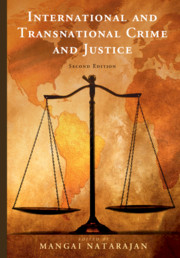Book contents
- International and Transnational Crime and Justice
- International and Transnational Crime and Justice
- Copyright page
- Contents
- Figures and Tables
- Preface
- About the Editor
- Notes on Contributors
- Introduction
- PART I OVERVIEW: TRANSNATIONAL CRIME
- PART II OVERVIEW: INTERNATIONAL CRIME
- PART III OVERVIEW: INTERNATIONAL AND TRANSNATIONAL CRIME RESEARCH
- 76 The US Uniform Crime Reports and the National Crime Victimization Survey
- 77 Highlights of the International Crime Victim Survey
- 78 The International Self-Report Delinquency Study (ISRD)
- 79 Advancing International and Transnational Research about Crime and Justice with Qualitative Comparative Analysis
- 80 Cross-National Comparisons Based on Official Statistics of Crime
- 81 Cross-National Measures of Punitiveness
- 82 World Criminal Justice Library Network
- 83 Printed and Electronic Media, Journals, and Professional Associations
- 84 Beyond the Usual Suspects Gray Literature in Criminal Justice Research
- World Map
- Index
- References
78 - The International Self-Report Delinquency Study (ISRD)
from PART III - OVERVIEW: INTERNATIONAL AND TRANSNATIONAL CRIME RESEARCH
Published online by Cambridge University Press: 20 June 2019
- International and Transnational Crime and Justice
- International and Transnational Crime and Justice
- Copyright page
- Contents
- Figures and Tables
- Preface
- About the Editor
- Notes on Contributors
- Introduction
- PART I OVERVIEW: TRANSNATIONAL CRIME
- PART II OVERVIEW: INTERNATIONAL CRIME
- PART III OVERVIEW: INTERNATIONAL AND TRANSNATIONAL CRIME RESEARCH
- 76 The US Uniform Crime Reports and the National Crime Victimization Survey
- 77 Highlights of the International Crime Victim Survey
- 78 The International Self-Report Delinquency Study (ISRD)
- 79 Advancing International and Transnational Research about Crime and Justice with Qualitative Comparative Analysis
- 80 Cross-National Comparisons Based on Official Statistics of Crime
- 81 Cross-National Measures of Punitiveness
- 82 World Criminal Justice Library Network
- 83 Printed and Electronic Media, Journals, and Professional Associations
- 84 Beyond the Usual Suspects Gray Literature in Criminal Justice Research
- World Map
- Index
- References
- Type
- Chapter
- Information
- International and Transnational Crime and Justice , pp. 476 - 482Publisher: Cambridge University PressPrint publication year: 2019



